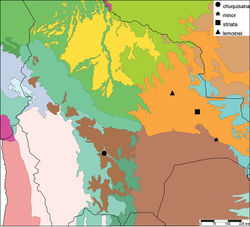Spixia striata
| Notice: | This page is derived from the original publication listed below, whose author(s) should always be credited. Further contributors may edit and improve the content of this page and, consequently, need to be credited as well (see page history). Any assessment of factual correctness requires a careful review of the original article as well as of subsequent contributions.
If you are uncertain whether your planned contribution is correct or not, we suggest that you use the associated discussion page instead of editing the page directly. This page should be cited as follows (rationale):
Citation formats to copy and paste
BibTeX: @article{Breure2016ZooKeys, RIS/ Endnote: TY - JOUR Wikipedia/ Citizendium: <ref name="Breure2016ZooKeys">{{Citation See also the citation download page at the journal. |
Ordo: Stylommatophora
Familia: Odontostomidae
Genus: Spixia
Name
Spixia striata (Wagner, 1827) – Wikispecies link – Pensoft Profile
- Pupa striata Wagner 1827[1]: 19.
- Helix spixii var. major d’Orbigny 1835[2]: 21 [nomen nudum].
- Pupa spixii var. α major
d’Orbigny 1838 [1834–1847]: 320; Breure and Ablett 2012[3]: 25, figs 22A–E, 22i.
- Spixia striata; Cuezzo et al. 2013[4]: 182 (references, synonymy).
Type locality
[Brazil] “in Provinciis S. Pauli et Sebastianopolitana”.
Type material
Not located.
Additional material
NHMUK 1854.12.4.232, lectotype (Breure and Ablett 2012[3]), and NHMUK 1854.12.4.232 (6), paralectotypes of Pupa spixii major d’Orbigny.
Diagnosis
Shell elongate-ovate, rather solid, broadly perforate, whitish with tawny blotches, sculptured with incrassate growth striae, suture slightly ascending behind the lip, aperture squarish oblique-ovate, with four teeth (small palatal lamella, indistinct basal lamella, concave columellar lamella entering the aperture, rectangular parietal lamella), peristome thickened, well expanded, narrowly reflexed.
Dimensions
Shell height 34.8, diameter 11.0 mm.
Distribution
Bolivia, Dept. Santa Cruz, Prov. Chiquitos (d’Orbigny 1838 [1834–1847]). Paraguay. Argentina (Cuezzo et al. 2013[4]). Brazil (Simone 2006[5]).
Ecoregion
Chiquitano dry forests [NT0212].
Remarks
Breure (2013: 14) discussed the need for an in-depth study of the variation of this wide-ranging species; preferably with anatomical and molecular research. The Bolivian record based on d’Orbigny (1838) “frontières nord de la province de Chiquitos” needs further confirmation. The Bolivian material which is found as Spixia striata in museum collections may need re-identification in the light of the recent split of the two varieties of d’Orbigny.
Taxon Treatment
- Breure, A; Avila, V; 2016: Synopsis of Central Andean Orthalicoid land snails (Gastropoda, Stylommatophora), excluding Bulimulidae ZooKeys, (588): 1-199. doi
Images
|
Other References
- ↑ Wagner J (1827) Testacea fluviatilia quae in itinere per Brasiliam annis MDCCCXVII–MDCCCXX jussu et auspiciis Maximiliani Josephii Bavariae regis augustissimi. Wolf, Monachii, iv + [ii +] 36 pp.
- ↑ d’Orbigny A (1835) Synopsis terrestrium et fluviatilium molluscorum, in suo per Americam meriodionalem itinere. Magasin de Zoologie 5(61): 1–44.
- ↑ 3.0 3.1 Breure A, Ablett J (2012) Annotated type catalogue of the Bothriembryontidae and Odontostomidae (Mollusca, Gastropoda, Orthalicoidea) in the Natural History Museum, London. ZooKeys 182: 1–70. doi: 10.3897/zookeys.182.2720
- ↑ 4.0 4.1 Cuezzo M, Miranda M, Ovando X (2013) Species catalogue of Orthalicoidea in Argentina (Gastropoda: Stylommatophora). Malacologia 56: 135–191. doi: 10.4002/040.056.0210
- ↑ Simone L (2006) Land and freshwater molluscs of Brazil. EGB/Fapesp, São Paulo, 390 pp.

